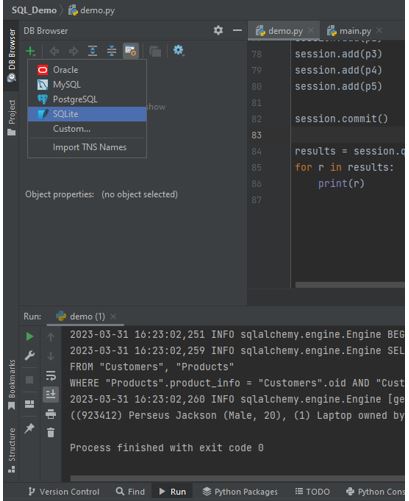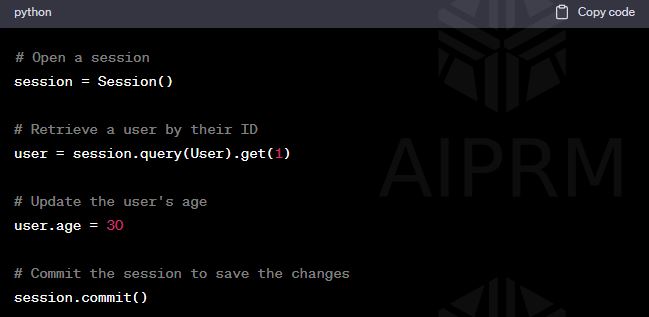Microsoft SQL Server Certification Training
- 6k Enrolled Learners
- Weekend/Weekday
- Live Class
SQL Alchemy is a powerful and popular Python library that provides an Object-Relational Mapping (ORM) tool for working with relational databases. It serves as a bridge between Python and various database management systems, allowing developers to interact with databases using Python code.
In this blog, we will discuss about the following topics:
The Python SQL toolkit known as SQLAlchemy enables programmers to manage and access SQL databases using the Pythonic domain language. For comparable searches of SQL Alchemy you can chain Python objects or write your query as a string. Developers have more freedom when working with objects, which also enables them to create high-performance SQL-based systems.
SQL alchemy features:
The object-relational mapping (ORM) technique is implemented by a software component known as an ORM mapper. A relational database’s data can be mapped to objects in an object-oriented programming language using a technique called ORM. The ORM mapper creates an abstraction layer between the database and the objects, allowing the manipulation of the objects without requiring knowledge of the underlying database structure.

An object-to-database table mapping is how the ORM mapper normally functions. The mapping specifies how the characteristics of the object relate to the columns in the database table. The translation between the objects and the database is subsequently performed by the ORM mapper using this mapping. The ORM mapper will insert an object’s data into the database table when the object is created. The ORM mapper will update the relevant data in the database table whenever an object is updated. The ORM mapper will remove the associated data from the database table when an object is destroyed.
SQLAlchemy provides a number of features that make it easy to work with databases in Python. These features include:
Overall, SQLAlchemy is a powerful and versatile library that can be used to interact with a variety of relational and NoSQL databases in Python.
You can also install SQLAlchemy from the source code. To do this, download the source code from the SQLAlchemy website and follow the instructions in the README file. Once you have installed SQLAlchemy, you can start using it to connect to a database and perform queries. For more information, please see the SQLAlchemy documentation.

Now, let me explain you this with demo how to implement SQL Alchemy with Python. You need to follow few steps to start using it.
pycharm IDE 🡪 Search “DB Navigator”



Master the language of databases with our comprehensive SQL Course.
CRUD, which stands for Create, Read, Update, and Delete, are the four basic operations that are performed on data stored in a database. These operations form the foundation of any database-driven applications. SQLAlchemy, you can perform CRUD operations using the following methods:
To perform CRUD operations in SQLAlchemy, we first need to define the schema for our data. A schema is a blueprint that describes the structure of the data that will be stored in the database. In our stock ticker tracking application, we will need a table to store information about the stocks that we are tracking.
To define the schema for our table, we will use SQLAlchemy’ s declarative base class, which provides a base class for creating the schema of our tables. First, we need to import the class and create an instance of it:

To perform read operations using SQLAlchemy, you can use query methods to retrieve data from the database. Here’s an example of a read operation using SQLAlchemy in Python:

To perform an update operation using SQL Alchemy, you can retrieve a record from the database, modify its attributes, and then commit the changes. Here’s an example of an update operation using SQL Alchemy in Python:

To perform a delete operation using SQL Alchemy, you can retrieve a record from the database and then remove it from the session. Here’s an example of a delete operation using SQL Alchemy in Python:

In conclusion, SQL Alchemy is a powerful Python library that provides a convenient and intuitive way to interact with relational databases. It allows you to perform CRUD operations (Create, Read, Update, Delete) efficiently and effectively. SQL Alchemy offers a flexible and comprehensive approach to database operations in Python, supporting various database management systems and providing a high-level API that simplifies the process of working with databases. For more such information, you can visit our website for interesting and informative blogs. https://www.edureka.co/
 Thank you for registering Join Edureka Meetup community for 100+ Free Webinars each month JOIN MEETUP GROUP
Thank you for registering Join Edureka Meetup community for 100+ Free Webinars each month JOIN MEETUP GROUPedureka.co